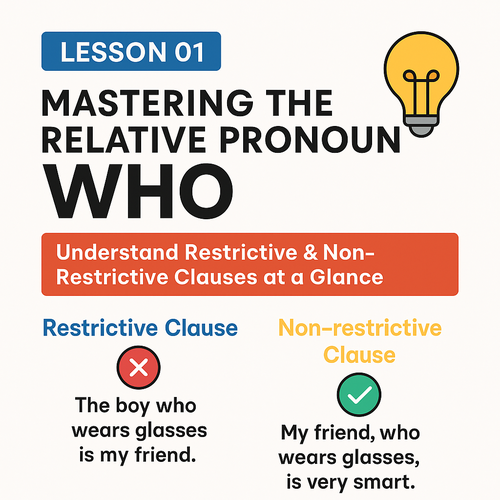✏️ Understand Restrictive & Non-restrictive Clauses at a Glance

🎯 Learning Objectives
- Learn how to combine two sentences with the same subject using the relative pronoun who.
- Practice rewriting sentences while keeping their meaning intact and grammatically correct.
- Understand the difference between restrictive and non-restrictive clauses, and when to use a comma.
🎥 Video Lesson
If you’re unsure about how to use who, start with this short and helpful video:
🔗 https://youtu.be/sVaRTI2jSZE?si=QnbJW9TcYQywPqHU
📎 What’s the Difference Between Restrictive and Non-restrictive Clauses?
| Type | Description | Comma | Example |
|---|---|---|---|
| Restrictive Clause | Gives essential information to identify the noun. | ❌ No comma | The boy who wears glasses is my friend. |
| Non-restrictive Clause | Adds extra (non-essential) information. | ✅ Use a comma | My friend, who wears glasses, is very smart. |
✨ Quick Tip
- ❗ No comma → Essential information → Restrictive Clause
- 💡 Comma → Extra information → Non-restrictive Clause
🧪 Example Sentences with Explanation
Example 1
The woman is my teacher. She is drinking coffee.
✅ The woman, who is drinking coffee, is my teacher.
🔍 “Drinking coffee” is not essential information. Use a non-restrictive clause with a comma.
Example 2
I saw the man. He was fixing the fence.
✅ I saw the man who was fixing the fence.
🔍 “Fixing the fence” tells us which man. Use a restrictive clause without a comma.
✍️ Practice: Combine These Sentences Using “Who”
- The boy is playing the piano. He is very talented.
→ _______________________________________________ - My sister helped the old woman. She was crossing the street.
→ _______________________________________________ - The girl is my best friend. She is standing at the front gate.
→ _______________________________________________ - This is the teacher. He gave me the award.
→ _______________________________________________ - The lady is kind. She takes care of many stray dogs.
→ _______________________________________________ - That man is speaking loudly. He is my uncle.
→ _______________________________________________ - I met a tourist. He came from Canada.
→ _______________________________________________ - The students cleaned the park. They participated in the campaign.
→ _______________________________________________ - That girl won first prize. She wrote a poem.
→ _______________________________________________ - Mr. Lee is our neighbor. He always greets us with a smile.
→ _______________________________________________
✅ Quick Answer Key
- The boy, who is playing the piano, is very talented.
- My sister helped the old woman who was crossing the street.
- The girl, who is standing at the front gate, is my best friend.
- This is the teacher who gave me the award.
- The lady, who takes care of many stray dogs, is kind.
- That man, who is speaking loudly, is my uncle.
- I met a tourist who came from Canada.
- The students who participated in the campaign cleaned the park.
- That girl who wrote a poem won first prize.
- Mr. Lee, who always greets us with a smile, is our neighbor.
📘 Friendly Explanations
1.
“Who is playing the piano” is extra information → Non-restrictive → Use a comma
2.
“Who was crossing the street” helps us identify the woman → Restrictive clause → No comma
3.
The girl is already known. Standing at the gate is extra info → Non-restrictive, use a comma
4.
“Who gave me the award” identifies which teacher → Restrictive, no comma
5.
Taking care of stray dogs is added info → Non-restrictive, comma used
6.
“Speaking loudly” adds extra info about the man → Non-restrictive, comma
7.
Coming from Canada identifies the tourist → Restrictive, no comma
8.
Only the students who joined the campaign are meant → Restrictive, no comma
9.
“Who wrote a poem” identifies the girl → Restrictive, no comma
10.
“Always greets us with a smile” is extra info → Non-restrictive, comma used
📝 Wrap-Up
By learning to use who correctly, you can write clearer, more natural English sentences.
Remember, the use of a comma depends on whether the information is essential or extra.
Keep practicing — and you’ll master it!
🧾 Copyright & Attribution
✅ This worksheet is designed for independent grammar practice.
✅ Suitable for upper elementary and middle school learners, teachers, and parents.
✅ Do not copy or resell this material. Please credit the source when sharing.
© 2025 Ddokddok Study Sheet | Powered by Sheetly. All rights reserved.
Contact: [sunnykrlee@gmail.com]